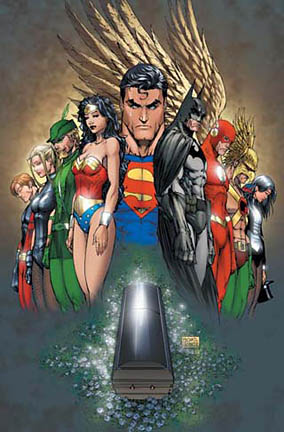
[ DRAWN & QUARTERED ]
Graphic Arts As Literature
COURTESY OF DC COMICS
DC superheroes deal
with ‘Identity Crisis’
Pop culture breeds familiarity, and with such coziness comes contempt. The thing about long-form immersive storytelling found in comic books is that the characters become much more recognizable than their surroundings and story lines.
Unless you're a die-hard comics fan -- and a duly responsible reader, always keeping up -- it's easy to lose your place in the current fictional universes of DC and Marvel comics. Too many inwardly tortured superheroes, too many colorful and easily expendable supporting characters, too many arch nemeses with long-forgotten grudges, too many universe-shaking cataclysmic plot developments; it's all too, too much. Just keeping up is a chore, and if you do, you feel vaguely guilty about doing so at the expense of dealing with day-to-day reality. (Which is exactly why readers escape into comics in the first place. It's very seductive.)
We're currently into a kind of Third Age of comic-book writing styles, one that has been around since the mid-'80s. After the initial plot-and-stunt scripting that carried comics into the '60s, Marvel's Stan Lee followed up with startling innovations in merging comic-book universes with both real-world social and psychological demands, coupled with classic storytelling arcs.
The new breed of writers who grew up reading Lee's work have moved into a kind of artful deconstruction of the medium itself. Previous generations were colored by the structures of novels, film and opera, all of which go from point A to Z. There are no such constraints in the immersive comic-book medium. The stories can be as big and as wide as the universe itself or as personal and tightly focused as a diary.
This is the sort of baggage one brings to DC's new, highly touted miniseries called "Identity Crisis," which began this month. It has a single story line that not only calls into question the entire galaxy of DC superheroes, it appears that all of them will be bit players. Supposedly, the rumbles will be felt throughout every comic that DC produces.
The teasing ad copy says the plot is super-secret and, based on the first issue, it's a murder mystery that will affect every hero and heroine, and cause waves of discomfort in each that even Dramamine won't help.
It's all a very solemn and high-minded soap opera. As comic book writers know, it ain't the plot, it's empathetic characters that carry an audience along, and writer Brad Meltzer, artist Rags Morales and inker Michael Bair are all in top form in sweeping us along. They are master storytellers. Their craftsmanship is impeccable, particularly in their economy of word and image.
At the same time, the primary characters are Elongated Man (Ralph Dibny) and wife Sue, Firehawk and Calculator. Say who? Supporting characters are Superman, Batman (I think), Wonder Woman and Green Arrow, all getting gracefully middle-aged, and all still fretting like adolescent schoolgirls about who said what to whom.
Unless one has kept up with the DC Universe, it's easy to get way lost in this sensitive, touchy-feely world. One can admire the work done in "Identity Crisis" without being drawn into it. But being drawn in has its own perils.
Click for online
calendars and events.

